As a contractor who has installed countless floors over the years, I’ve seen firsthand how the right flooring choice can transform a space. Tile remains one of the most versatile options available, but is it right for your project? Today, I want to provide an honest, no-nonsense comparison between tile and other popular flooring materials to help you make the best decision for your home.
Installation Considerations: Time and Complexity
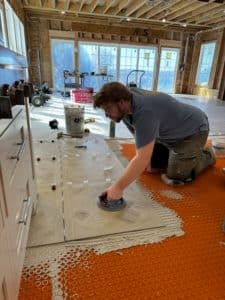
Tile Installation: The Reality Check
Tile installation is admittedly more time-consuming than many other flooring options. I typically tell homeowners to expect a multi-day process, especially for larger areas. The subfloor preparation, tile setting, drying time, and grouting all require patience and precision.
For a medium-sized kitchen, you might be looking at 2-4 days before the floor is fully usable. This timeline extends further with complex patterns, smaller tiles, or specialty installations.
How Other Materials Compare
Laminate and luxury vinyl plank (LVP) installations can often be completed in a single day for the same space. These click-together systems eliminate drying times and can sometimes be installed right over existing floors.
Hardwood typically falls somewhere in the middle, requiring acclimation time before installation but featuring faster installation than tile. Carpet installation is generally the quickest of all major flooring types.
Cost Factors: Beyond the Price Tag
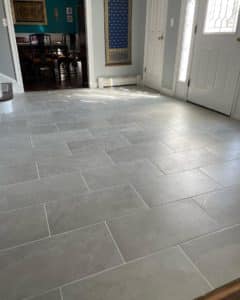
Tile’s Investment Profile
Tile typically has a higher upfront cost than options like vinyl or laminate. The material itself varies widely in price, from basic ceramic to high-end porcelain or natural stone. Installation costs are also higher due to the labor-intensive process and specialized tools required.
However, when considering lifetime cost, tile often becomes more economical. A properly installed tile floor can last decades with minimal replacement needs.
Other Materials’ Cost Structures
Luxury vinyl and laminate offer lower initial costs but typically need replacement every 10-15 years. Hardwood carries a premium price tag similar to higher-end tile but offers refinishing options to extend its life. Carpet is often the most budget-friendly initially but requires the most frequent replacement.
Maintenance Requirements: The Real Story
Caring for Tile Floors
Let’s be honest – tile maintenance has pros and cons. The surface itself is incredibly easy to clean with simple sweeping and occasional mopping. However, grout lines can be challenging, especially with smaller tiles that create more grout area.
I recommend sealing grout upon installation and periodic resealing every few years. For daily cleaning, a pH-neutral cleaner will keep tiles looking their best without damaging grout.
Maintenance for Alternative Flooring
Hardwood requires careful moisture management and occasional refinishing. Laminate and vinyl are low-maintenance but can’t be refinished if damaged. Carpet demands regular vacuuming and periodic deep cleaning to maintain appearance and hygiene.
Durability Comparison: What Really Lasts?
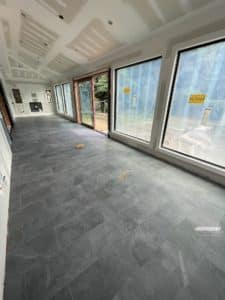
Tile’s Durability Profile
Tile ranks at the top for durability among flooring materials. In high-traffic areas, quality tile can last 50+ years with minimal signs of wear. It resists scratches, stains, and moisture damage better than virtually any alternative.
The weak point? Tile can crack if something heavy is dropped or if the subfloor shifts significantly. However, having a few spare tiles allows for individual replacement without redoing the entire floor.
How Other Flooring Materials Hold Up
Hardwood shows wear patterns in high-traffic areas but can be refinished several times. Laminate and vinyl are resistant to surface stains but can be permanently damaged by scratches or dents. Carpet typically shows wear within 5-10 years in busy areas of the home.
Comfort and Practical Considerations
The Reality of Living with Tile
I always tell clients that tile’s biggest comfort drawback is its coldness underfoot, especially in winter months. This can be mitigated with in-floor heating systems, but that adds to the installation cost.
Tile is also harder on your feet when standing for long periods compared to more resilient materials. Area rugs can help in spaces where you stand frequently.
Comfort Factors of Other Materials
Carpet obviously provides the most cushioning and warmth. Vinyl and laminate offer a middle ground – not as cold as tile but not as soft as carpet. Hardwood remains cool but typically feels warmer than tile to the touch.
Style and Design Flexibility
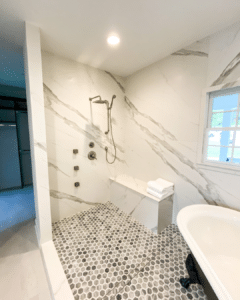
Tile’s Design Versatility
Tile offers unmatched design flexibility. From tiny mosaic patterns to large-format slabs, from classic subway designs to cutting-edge printed patterns, the options are virtually limitless.
Modern technology has expanded these options further with tiles that convincingly mimic wood, stone, concrete, and even fabric textures. This allows you to achieve almost any aesthetic with the practical benefits of tile.
Design Options with Alternative Materials
Other flooring materials have their own design strengths. Hardwood offers timeless beauty with natural variation. Laminate and luxury vinyl have dramatically improved their visual realism. Carpet comes in countless colors and textures but is more limited in pattern options.
Long-Term Value and ROI
When considering home value, well-installed tile consistently ranks high for return on investment. It’s particularly valuable in bathrooms, kitchens, and entrance areas where moisture resistance and durability are paramount.
Hardwood similarly maintains strong resale value. Laminate and vinyl, while improved in recent years, typically don’t add significant property value. Carpet generally doesn’t increase home value and may even detract from it in some markets.
Making the Right Choice for Your Home
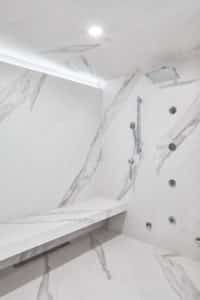
The best flooring choice ultimately depends on your specific needs:
- For high-moisture areas like bathrooms and laundry rooms, tile is hard to beat
- For families with pets, tile or luxury vinyl typically perform best
- For bedrooms where warmth and comfort are priorities, carpet or hardwood might be preferable
- For whole-house cohesion, large-format tile or luxury vinyl planks offer consistent flow
My Professional Recommendation
After years in the industry, I believe tile is an excellent investment for the right spaces. While it demands more installation time and higher initial costs, its longevity, low maintenance (outside of grout cleaning), and timeless appeal make it cost-effective long-term.
However, I’m equally quick to recommend alternatives when they make more sense for a client’s specific needs and budget. The best flooring choice is one that balances your practical requirements, aesthetic preferences, and budget constraints.
If you’re considering tile for your next flooring project and want expert guidance on whether it’s truly the right choice for your space, I’d be happy to provide a personalized consultation. Every home is unique, and having a professional assessment can help you make the most informed decision for your flooring investment.
